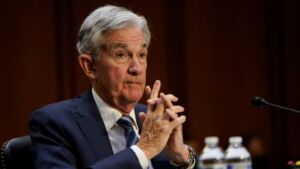The Federal Reserve is widely expected to raise interest rates by another three-quarters of a point Wednesday, and it could surprise markets by sounding even more unrelenting about tightening policy.
That means the Fed would sound “hawkish,” or in a mode where it is bent on raising interest rates as much as it needs to in order to curb inflation. The central bank is expected to announce the rate hike Wednesday at 2 p.m. ET. Fed Chairman Jerome Powell then briefs the media at 2:30 p.m. ET.
A 75-basis point or three-quarter point hike would put the fed funds rate in a range of 2.25% to 2.5%. The Fed started raising interest rates in March when the fed funds range was zero to 0.25%.
Investors will be looking for guidance from Powell on what the Fed could do at its next meeting in September. For a period this month, markets had even braced for a full-point hike, but Fed officials discouraged that view.
“I do think they’re going to lean a little bit more hawkish on September,” said Jim Caron, head of macro strategies for global fixed income at Morgan Stanley Investment Management. “They’re just not seeing the progress on inflation.”
‘Two-handed economist talk’
The Fed could provide fresh commentary on the economy, which it may acknowledge is slowing.
“There’s going to be a lot of two-handed economist talk from Jay Powell,” said Vincent Reinhart, chief economist at Dreyfus and Mellon. “He’s going to say we’re definitely going through a soft inventory and trade cycle.”
Reinhart said while Powell should acknowledge slower growth, the chairman may also say that there is fundamental support for the economy. The labor market is still strong though jobless claims have begun to rise.
“I think it’s going to be a mixed bag. He’s going to be talking ahead of what could be another quarter of real GDP decline,” Reinhart said.
The Fed’s two-day meeting winds down on the eve of Thursday’s release of second-quarter gross domestic product, which is expected by some economists to show a contraction. That would suggest the economy could be heading for recession — and some believe it technically would be in one because it would be the second negative quarter in a row.
However, the National Bureau of Economic Research uses other criteria to judge a recession, and it is not expected to declare one yet, Reinhart said.
Even so, some traders are betting the Fed will ultimately cause a recession with its aggressive policy tightening. Powell is expected to reinforce the Fed’s rate hiking trajectory, and that could sound hawkish.
“He could talk about the cycle going well into next year,” said Michael Schumacher, Wells Fargo director rates strategy. “The market is pricing a pretty quick end to the hiking cycle. That’s just not realistic. I think he’ll sound pretty hawkish.”
The futures market is actually pricing in an about-face by the Fed next year. Traders are betting the Fed will begin cutting rates by next spring, after taking the fed funds rate to 3.4% by the end of this year.
‘Inflation is not coming down’
For now, hot inflation will likely keep the central bank raising rates. The consumer price index rose 9.1% in June, the highest consumer inflation since November 1981.
“We have yet to see sequential core CPI falling,” said Caron. “To me, if this is a major threshold for them then they’re going to continue to be aggressive. They could communicate that. That would sound hawkish.”
Core CPI, excluding energy and food, rose 0.7% in June, up from 0.6% in May.
A hawkish-sounding Fed could cause shorter duration Treasury yields to rise, and stocks to sell off after the meeting, Caron said. If longer duration yields, like the 10-year Treasury note, continue to fall on recession fears, the yield curve will invert even further.
The yield curve is inverted when shorter duration yields, like the 2-year Treasury rise above longer duration yields, and it is often viewed as a recession warning. The 2-year, which most reflects Fed policy, was yielding about 20 basis points more than the 10-year on Monday.
“Major problem: inflation is not coming down,” said Caron. “They’re not going to really tell you this but that’s the problem.” He added, that the Fed will not be deterred by falling asset prices as rates rise.
“They can’t say they’re making progress on inflation. They can’t say they even have one month in a row of success,” Caron said. “They’ll probably say policy interest rates are helping slow the economy. It works with a lag.”
A lot of voices at the Fed
Diane Swonk, the chief economist at KPMG, said Powell’s job will be more difficult since there are diverse views inside the Fed on whether it should hike more or less.
“There’s still going to be a debate within the Fed. You have suddenly a lot of voices. This is the first time they’re fully staffed, and you have more Fed presidents,” she said. “There’s the debate of whether they go faster or slower now. The messaging gets more complicated for Powell, given the diversity of views.”
Powell may also be vaguer than he was at the last meeting and leave his options open when it comes to September.
“At the past few meetings, Chair Powell has signaled (or mis-signaled) the expected size of the rate move at the subsequent meeting. We don’t expect him to be so definitive,” said Michael Feroli, JPMorgan chief economist. “While he will almost certainly indicate that the committee expects to continue tightening policy, with two jobs reports between now and the September meeting, we don’t see the upside to putting a stake in the ground in late July. Powell will very likely get asked about the chance of recession; we suspect he will say it’s a risk but not a foregone conclusion.”

